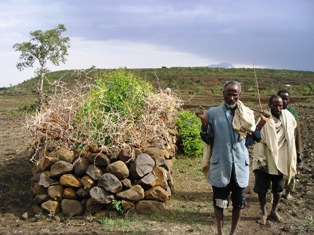 The future of pastoralism in Africa is uncertain. Pastoralist areas are experiencing radical changes in access to key resources, options for mobility and opportunities for marketing and trade. These changes present new threats and possibilities for making pastoralist livelihoods stronger. The expansion of irrigation schemes in drylands for commercial agriculture backed by foreign governments and private equity is restricting pastoralist’s access to high value fodder and water.
The future of pastoralism in Africa is uncertain. Pastoralist areas are experiencing radical changes in access to key resources, options for mobility and opportunities for marketing and trade. These changes present new threats and possibilities for making pastoralist livelihoods stronger. The expansion of irrigation schemes in drylands for commercial agriculture backed by foreign governments and private equity is restricting pastoralist’s access to high value fodder and water.
Banditry and new predatory forms of violence in some pastoral areas are greatly destabilising, and also constraining people’s mobility and resource access. At the same time, the economic contribution of pastoralism to local, national and regional economies, although still greatly undervalued, is beginning to be recognised. The marketing opportunities for pastoralists are increasing with urbanisation. Export markets for meat and hides are flourishing as economic ties deepen between some parts of sub-Saharan Africa and neighbouring regions, particularly the Arabian Peninsula. There are other significant developments in financial services and access to micro-finance and insurance for pastoralists, as the recently established livestock insurance scheme in northern Kenya exemplifies.
Still, in spite of expanding economic opportunities in the livestock sector, there are few options for pastoralist ‘drop outs’. The inheritance of destitution limits options for the poorest to reconnect socially and economically with the productive parts of pastoralist societies. Small towns in pastoralist areas are growing and are significant for livelihood diversification, value addition, marketing and exits from pastoralism. Yet destitute pastoralists in towns that depend on various tasks for cash have few opportunities to build more effective livelihoods. The creation of viable alternative livelihoods is essential yet the lesson from past interventions is that alternative livelihoods must not be disconnected from the productive livestock economy. Recent improvements in the delivery of aid and services include decentralising distribution systems for provision in remote locations where pastoralists move to, thus allowing pastoralists the option of moving while still continuing to receive assistance. Major innovations in mobile education for pastoralists have transformed opportunities in some places. Other critical lessons for supporting people in pastoral areas are to be learned from social protection measures such as the Productive Safety Net Programme in Ethiopia and the Hunger Safety Net Programme in Kenya.
The changing context for pastoralist production and livelihoods in Africa is leading to new debate and reflection on pastoralist futures. Events such as the severe drought that affected the Horn of Africa in 2009, and the localised violence and grim humanitarian consequences that followed, played into a narrative that climate change is worsening resource scarcities and acting as a catalyst for conflict and social breakdown. The climate change debate has resuscitated concerns that the carrying capacities of rangelands have been reached, suggesting that stocking rates may need to be reduced in response to climate-induced changes in the availability of fodder and water. However, a very different and compelling perspective is that pastoralists generate enormous economic prosperity from Africa’s drylands and that mobile livestock keeping is more resilient to global climate change than are other land use systems, including sedentarised forms of dryland agriculture that are often promoted as being alternative livelihoods for poor pastoralists. African pastoralists contribute significantly to national economies and growth. In Ethiopia the livestock sector ranks second to coffee in generating foreign exchange, in 2006 totalling US$121 million from livestock and livestock products. In Chad, over one third of exports are from pastoralist livestock and they feed 40% of the population. In Kenya livestock raised by pastoralists is worth US$ 800 million a year. In Somalia booming livestock trade links with the Arabian Peninsula have helped its economy flourish in spite of state collapse showing that even in the absence of a state pastoralists are helping to grow national economies and feed populations. These experiences suggest that the standard narrative that pastoralism is in crisis is incomplete.
This conference provides an opportunity for critical reflection on the future of pastoralism in Africa and to share new learning from the dynamics of change and innovation happening in pastoralist areas. Is there a future for a productive, vibrant, market-oriented livelihood system? Or will pastoralist areas remain a backwater of underdevelopment, marginalisation and severe poverty? How will pastoralist ‘drop-outs’, who nonetheless continue to interact with the livestock sector in a multiplicity of ways, best be supported?
